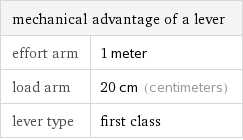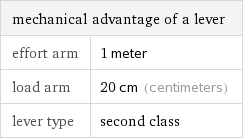MECHANICAL ADVANTAGE OF SIMPLE MACHINES
Mechanical advantage is a term that is used to describe the amount of force that is utilized internally by some sort of mechanical device. The mechanical advantage allows the device to perform the task for which it was designed. Many common tools that are used in the home and in construction make use of this principle.
One of the best ways to understand the idea of mechanical advantage is to consider the simple action that takes place between a screwdriver and a screw. Force is exerted on the screwdriver, causing the body of the tool to rotate while at the same time pressing the screw into some sort of surface, such as a wooden block. The combination of rotational force and forward movement make it possible for the screwdriver to use mechanical advantage to secure the screw into the medium.
Lever
The lever is one of the six simple machines. It is made of a board or rigid object that pivots around a fulcrum. The lever works by transferring an applied force over a distance and exerting an output force on an object. The lever increases the magnitude of the output force by sacrificing the distance this force is applied over. The effectiveness of the lever can be shown by calculating the mechanical advantage (MA) for the lever.
The mechanical advantage of a lever is the ratio of the length of the lever on the applied force side of the fulcrum to the length of the lever on the resistance force side of the fulcrum. There are three types of levers - class 1, class 2, and class 3.
How to calculate the Mechanical Advantage in a Lever
- Identify the fulcrum. This will be the point about which the the board or rigid object pivots around.
- Identify the locations of the input and output forces. The input force is the force that is applied to the lever, oftentimes by a machine or human. The output force is the force that the lever exerts onto an object.
- Find the distance between the fulcrum and the input force. This is known as the resistance arm.
- Find the distance from the fulcrum to the output force. This is known as the effort arm.
- Divide the length of the effort arm by the length of the resistance arm to calculate mechanical advantage.
MA = L (effort arm) / L(resistance arm)
Only class 1 or class 2 levers can be used to gain a mechanical advantage.
| Input Information | Equation | ||
|
|
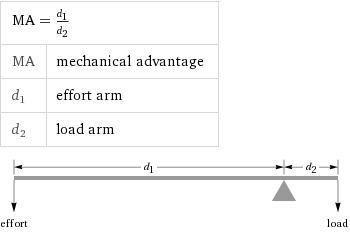 |
||
| Result | |||
 |
| Input Information | Equation | ||
|
|
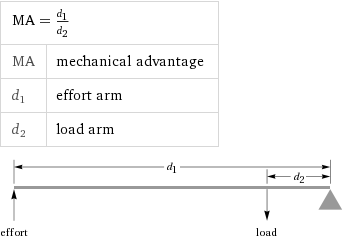 |
||
| Result | |||
 |
| Input Information | Equation | ||
|
|
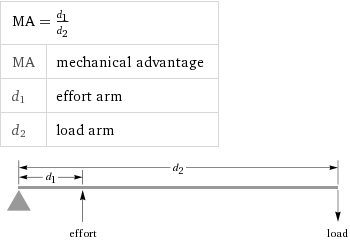 |
||
| Result | |||
 |
Wheel and Axle
The wheel and axle is a simple machine involving two connected circular objects of different sizes. When the axle turns, the wheel also turns. The mechanical advantage is the relationship between the force and distance inputted and outputted by the wheel and axle and is directly related to the radius of the wheel and the axle. The mechanical advantage of a wheel and axle is the ratio of the radius of the wheel to the radius of the axle. In the wheel and axle illustrated below, the radius of the wheel is six times larger than the radius of the axle. Therefore, the mechanical advantage is 6:1 or 6.
Note: The radius is equal to 1/2 the diameter of a circle.
The wheel and axle can also be used to increase speed. This is done by applying the input force to the axle rather than a wheel.
The increase in the output speed will be directly proportional to the ratio of the diameter of the wheel and axle. For example, if the diameter of the wheel is 10 inches and the diameter of the axle is 2 inches, the output speed will be increased 5 times (10:2 or 5:1).
How to calculate the Mechanical Advantage of a Wheel and Axle
- Find the radius of the larger wheel. In a real-world setting, this value can be obtained by directly measuring with a tape measure or ruler. In a math problem, this value is sometimes given.
If it is not, it can be calculated with the formula C=2 (pi) (r) by knowing the circumference (C) of the wheel and solving for r. - Find the radius of the axle. This can be achieved by using the same methods as finding the larger radius.
- Divide the radius of the large wheel by the radius of the axle to find the mechanical advantage.
MA =r (large wheel )/ r (axle)
| Input Information | Equation | ||
|
|
 |
||
| Result | |||
 |
Inclined Plane
An inclined plane is a type of simple machine that consists of a slope between two points, for example a ramp. Since work equals force times distance, changing the distance over which a force is applied creates a proportional change in the force while the amount of work remains constant (ignoring friction). The inclined plane allows a smaller force to be applied over a greater horizontal distance to produce the same change in vertical distance as without the inclined plane. This change in force and distance is known as the mechanical advantage. In an inclined plane, the formula for mechanical advantage is the length of the slope divided by the height of the inclined plane (mechanical advantage = slope length/height).
| Input Information | Equation | ||
|
|
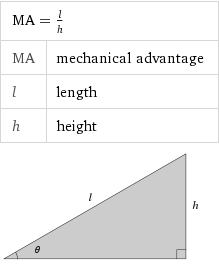 |
||
| Result | |||
 |
Pulleys
A pulley, which is derived from the Greek word polos, meaning axis, is a wheel with a groove. A rope, belt, or cable runs inside the groove. That mechanism can be used alone or connected with other pulleys in a pulley system. The greater the number of pulleys in the system, the less force it will take to lift an object. Try to lift a 50-pound boulder with just your arms and then use a pulley to pick it up. The pulley makes lifting the boulder easier because it reduces the effort required to lift. But notice that, although lifting becomes easier, you pull a rope that travels a greater distance than the height to which you lift the boulder. This extra distance decreases your effort by giving you a mechanical advantage. The mechanical advantage of a moveable pulley is equal to the number of ropes that support the moveable pulley. (When calculating the mechanical advantage of a moveable pulley, count each end of the rope as a separate rope). You can calculate this number for any pulley system using the following methods.
How to calculate the Mechanical Advantage in a Pulley
By Calculation
- Find the mechanical advantage of a pulley system by noting how many doubled-up stretches of rope or line must shorten for the load to be lifted. Denote it with the letter n. For example, if the line passes between two blocks of pulleys four times then n=4. Proceed to Step 3.
- Find the mechanical advantage of a leverage system by noting how far the load's point of contact on the lever is from the fulcrum. Denote it L. Note how far the force input's point of contact on the lever is from the fulcrum. Denote it F.
Calculate n = F/L. - Write n as a ratio of integers. For example, if n=1.5, then write 3:2, because 3/2 is equal to 1.5.
This is the mechanical advantage of the system.
Empirically
- Measure the weight of the load or the force of friction exerted by the load by lifting or pulling it with a spring scale, but only enough to just make it move.
- Attach the pulley or lever system to the load.
- Attach a measuring device at the point of force input. For example, use a floor scale if the force is pushing and a spring scale if the force is pulling.
- Divide the load's force by the input force. This ratio is the mechanical advantage.
| Input Information | Equation | ||
|
|
 |
||
| Result | |||
 |
| Input Information | Equation | ||
|
|
 |
||
| Result | |||
 |
Wedge
A wedge is characterized by an object that has a defined width at one side that slopes to a point at the other end. This simple machines allows a force that is applied over a large area to be concentrated upon an edge or smaller area, such as a knife. This concentration of force is the mechanical advantage (MA) the wedge provides. Each of the six simple machines offers a mechanical advantage, and it can be quickly calculated for a wedge. The mechanical advantage of a wedge can be found by dividing the length of either slope (S) by the thickness (T) of the big end.
How to calculate the Mechanical Advantage of a Wedge
- Find the length of the sloped surface of the wedge. For a real-world object, this can be found in by measuring with a tape measure or ruler. In the case of a math problem, this value is sometimes given.
If it is not, it can be calculated using the Pythagorean Theorem a2 + b2 = c2 or
the law of cosines cos (a ) / A = cos (b) / B = cos (c) / C - Find the width of the large end of the wedge. This too can be found either by direct measurement or by mathematical calculation.
- Divide the slope length by the width of the wedge to find the mechanical advantage.
MA = Slope Length / Width
| Input Information | Equation | ||
|
|
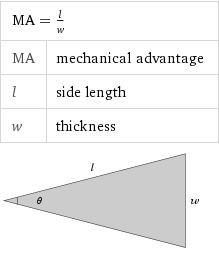 |
||
| Result | |||
 |
Screw
A screw is a simple machine that works as a modified incline plane. As the screw is turned, the screw enters deeper into the substrate. Once inside the substrate, the frictional force of the thread is intended to prevent the screw from rotating back out of the substrate. The thread of the screw may be viewed as an inclined plane wrapped around the shaft of the screw. The slope of the screw is the distance for one complete rotation around the screw while the height of the inclined plane is the distance between the threads, known as pitch. The relationship between the pitch and circumference of the screw gives the mechanical advantage. The mechanical advantage of a screw can be found by dividing the circumference of the screw by the pitch (lead) of the screw.
How to calculate the Mechanical Advantage of a Screw
- Measure the pitch of the screw. The pitch of the screw is the distance between the threads and is determined by measuring the number of threads per inch (or centimeter) on the screw then dividing one by the number of threads (pitch = 1 / number of threads per inch or cm). For example, if a screw has eight threads per inch, the pitch is 1/8.
- Measure the circumference of the screw. Circumference is calculated by measuring the diameter of the screw and multiplying by pi (circumference = diameter of the screw x pi). For example, if a screw has a diameter of 0.25 inches, then the circumference of the screw is 0.79 inches (0.25 inches x 3.14 = 0.79 inches).
- Calculate the mechanical advantage of the screw by dividing the circumference of the screw by the pitch of the screw. Using the previous examples, a screw with a pitch of 1/8 and a circumference of 0.79 inches would produce a mechanical advantage of 6.3 (0.79 inches/ 0.125 = 6.3).
| Input Information | Equation | ||
|
|
 |
||
| Result | |||
 |
